

Microcosm
It was the best of times and it was the worst of times. 26 days. 26 days with 200 mb of data per day. 26 days with no social media. 26 days without seeing land. 26 days without ever having to make a meal or clean dishes. A cruise is a marathon in which you are marveling at the most beautiful sunset you’ve ever seen with friends in one moment and in the next you are desperately working on an instrument at 3 a.m. equipped exclusively with the tools on hand and manuals that you brought. These are two experiences that I am intimately acquainted with, however I won’t inflict upon you an image of what I look like running on two hours of sleep!

(from left to right) Bryce, Brianna, and Savannah (me) enjoying the calm before the storm… rather the calm before Hurricane Jose during NAAMES 3.
NAAMES is the first field campaign that I have participated in and I had no idea what life would be like living on a ship for 26 days. How do you pack for it? Will they provide blankets and pillows? How can you plan to feed 60 people for 26 days? In case you were wondering, the answers are: layers, don’t forget your chargers, they do provide bedding, and I still have no idea but it is an incredible feat. While there are a myriad of practical decisions that must be made in regards to the science aspect that one can prepare for, the personal experience of living within 273 feet of 60 people for 26 days is something that is hard to accurately describe. However, I won’t let that stop me from trying.
I am on an opposite schedule of my bunk mate, so I wake up within the range of 1:45 -4:50 a.m. everyday. I set out my clothes every night so that I can quietly slip into new clothes, brush my teeth, and put on sunscreen all without ever turning a light on. There is always someone awake and working within the ship, but in the early mornings, greetings are mostly left to cordial grunts on the way to coffee. As time goes on, small rituals begin to develop due to the close proximity. This is my second NAAMES cruise and several of the graduate students have a religious attendance to two events that we created during the last cruise: coffee club and sunset sing-alongs. In addition to being fans of alliteration, we are able to have a communal time in discussing not only anecdotal stories, but about our science. There are a wide variety of fields that work together for the NAAMES cruises and it’s vital for the atmospheric scientists, biologists, ecologists, etc. to compare data and speak the same language, so to speak. These casual meetings have greatly enhanced my understanding of the complex biological interactions that are occurring, and I have helped others understand the atmospheric data that my group is analyzing.
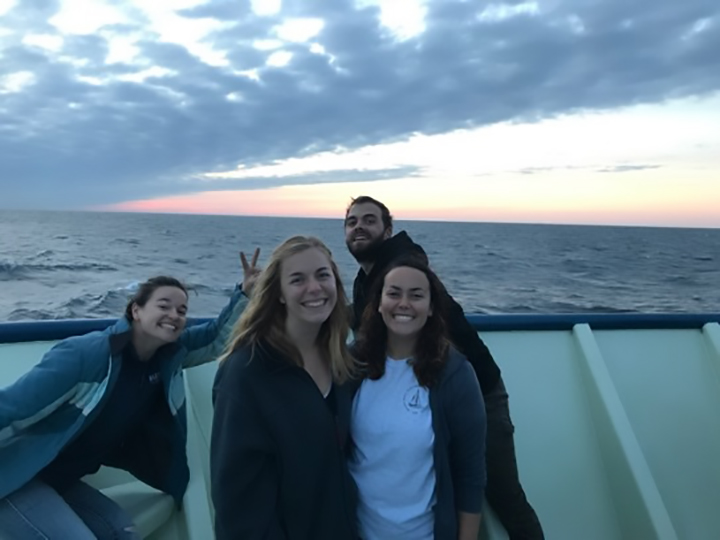
(from left to right) Cleo, Savannah, Brianna, and Sean enjoying the sunset before loudly singing ‘My Heart Will Go On’ by Celine Dion on the bow of the ship.
What is life like on the ship? Generally, no one wastes data on the news, so we make our own little world that revolves around phytoplankton and food. In a world full of chaos and uncertainty, for a short 26 days, we can live in a small isolated world of friends, food, and incredible science.
Written by Savannah Lewis
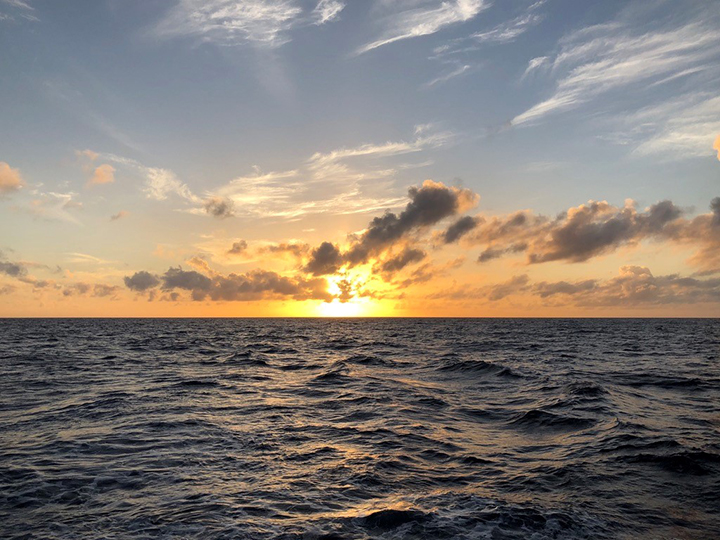
Sunset aboard the R/V Atlantis
As the sun begins to dip below the horizon, the dulcet tones of Celine Dion join the cacophony of the crashing waves and whipping wind. The multicolor sky provides a picturesque backdrop for the momentous drum solo performed by none other than Bri Hendrickson. For some of us, sunset sing-alongs occur nightly on board the R/V Atlantis. Few moments on the boat offer such a cathartic experience. For a few brief moments, nothing else matters except the vast ocean in front of you and the sheer freedom of singing to the world’s largest audience: the ocean.
These sing-alongs are just one example of bonding on the boat. Science may be the reason for our month on the sea, but the moments between frantic operations are where the friendships form and life-long relationships and collaborations are solidified. Sunset sing-along is one of those moments that truly transformed some of us from colleagues to friends. After belting out “My Heart Will Go On” on the bow of the boat for weeks straight, you have little reservations left. Coffee club is another experience that draws people together. Multiple groups devote time to come together and drink this highly precious liquid. Some groups even bring their own espresso machines to up the ante. These creature comforts bring us all together, especially due to our close proximity on the ship.
These bonding moments are crucial when living together with an assortment of people from all over the country and world. Large projects such as NAAMES bring together such a diverse group of people with one major commonality: a burning desire to know more. Conversations run the gamut from directly related to the project to life stories that serve to only enrich our already diverse team. One strength of this project is our inherent diversity – both scientific and individual diversity. NAAMES incorporates biologists, chemists, journalists, and these are merely our careers. Cramming 30 people into a 300-foot shop sounds daunting, but I promise you that life on this moving ‘island’ is everything you can imagine and more.
NAAMES 4 has just begun, but these traditions live on strong. Though I may be a newer addition to the group, it is clear that the seasoned participants have their own traditions that make a month on a ship a little less intimidating. Sunset sing-alongs have been a memorable aspect of the NAAMES cruises for me, but I am sure that we can all think of our one thing that keeps us smiling here on the boat. When the NAAMES campaigns come to an end in a month, these moments will be the intangible keepsakes we all take away from the ship and hold onto for a lifetime
Written by Bryce Penta
Adios, San Juan!
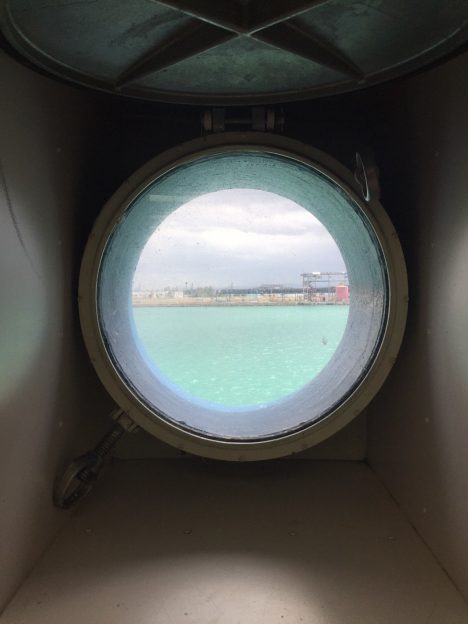
View of the water from a porthole in the main lab on board the R/V Atlantis
Today, we said goodbye (or rather adios) to the port of San Juan and hello/hola to the Atlantic Ocean. The past few days have been a whirlwind of unpacking, setting up our gear, securing our gear, mounting sensors, stretching cable from one end of the ship to the other, testing instruments, attending safety briefings and science meetings, meeting our fellow scientists and getting to know the crew…all while trying to fit in some exploring in Old San Juan and soaking up the Caribbean sun and sea while we can! After working for most of the day in the hot sun, carrying boxes in and out of labs and pinning sensors to the highest possible points on the ship, it was a treat to walk just a few blocks from the ship to a public beach with a protected inlet for swimming a few laps in the crystal clear ocean. As if this beach could get any more picturesque, after passing showers in the afternoon, the scene was perfectly set for a rainbow over the horizon. We oceanographers are certainly lucky when our work takes us to such stunning places.
This morning (after one last ocean swim for the dedicated masters swimmers J), we waved goodbye to the fans and helpers who came to see us off. We sailed out of the Isleta de San Juan, where R/V Atlantis has been docked for the past several days, past the old fort, and into deeper waters. Once underway, we practiced muster drills to know where to go and what to do in the unlikely event of an emergency. The science team has never looked more glamorous than when we all donned our immersion suits together—30+ people getting used to the new roll of the boat, bumbling around in our gumby suits. Let’s hope someone took a picture.
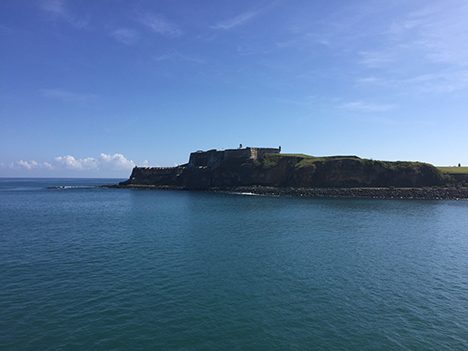
View of an old fort as the R/V Atlantis sailed out of the Isleta de San Juan towards deeper waters.
With Puerto Rico fading into the background, we watched the water color change from the bright, milky turquoise (filled with the occasional reef fish or even an octopus darting under the ship last night!) of the inland lagoon to a deep azure dotted with whitecaps. As a member of the Optics Team onboard NAAMES 4, my lab mate James Allen and I are always interested in characterizing the color and brightness of the ocean to tell us more about what is in the water. When we get on station in a few days, we will use a number of different sensors to tell us about the light hitting the surface of the ocean and how that light is absorbed and scattered by water and other things as it travels to depth. We have sensors mounted on the ship to measure the light coming from the sun, and we will send other instruments down into the water to describe the concentration of phytoplankton and other particles.
We may have said farewell to the rocky reefs and white sands of San Juan, but there was a perceptible air of excitement from everyone on the ship as we finally started to move. Now, with dreams of spring blooms and calm seas (not likely, but we can dream!), we face our next adventure: the North Atlantic!
Written by Sasha Kramer
In 30 days I’ll be a salty veteran. I’m going out to sea for 3 1/2 weeks with a group of scientists I’ve never met, a fellow lab mate, and a professor from Rutgers. We’re traveling to the North Atlantic to cleverly observe the largest assemblage of phytoplankton on our planet. I’ve heard these research expeditions are grueling – not much sleep every night, waking at impossible hours (11pm), and intense sampling work every day for weeks on end. However, as I become accustomed to the ship and the crew of scientists, engineers, and deckhands as we set up our mobilized laboratory, I can feel the sense of community and warmness, not of stress and hardship. My lab mate hugs every scientist he knows as he sees them for the first time since the last expedition, and I meet scientists from around the USA. Exuberant scientists from different labs are explaining how their instruments work to others, just for the sake of learning.
Each scientists knows their duty – to propel their minds past the limits of what they know about their surroundings, and report back. However, even amongst the high level of expertise and knowledge of professors and NASA employees, I don’t feel a sense of competition.

View of the R/V Atlantis from the San Juan, Puerto Rico dock
Today, docked in San Juan, we prepare for deployment, and diverse groups of scientists bond over beer after work. Some set up planes which fly by our ship when it will venture into the Atlantic, and collect cloud samples. Some are constructing scaffolds which collect the mist pushing off of the sea surface. Our lab collects samples of seawater at various depths. Each lab has sent out experts in their field, taking as many samples as they can.
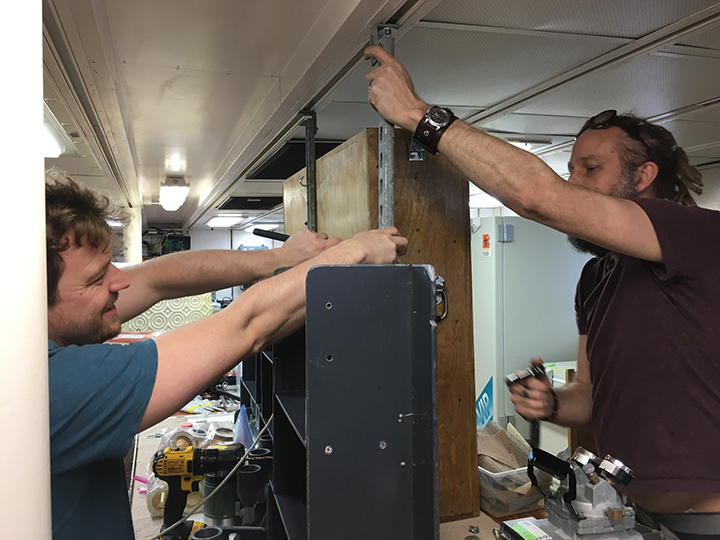
Ben Diaz (left) and Kay Bidle (right) making the dream work
When it’s over, it’s up to each lab group to coordinate with other scientists and piece together a picture of what’s happening. Can phytoplankton influence cloud formation? Is it possible that this mass of phytoplankton contributes to what we call seasons? How do different particles or plastics found in seawater influence the interaction between phytoplankton and the atmosphere? We don’t know how the pieces will come together just yet, but we all love the process.
Written by Ben Diaz